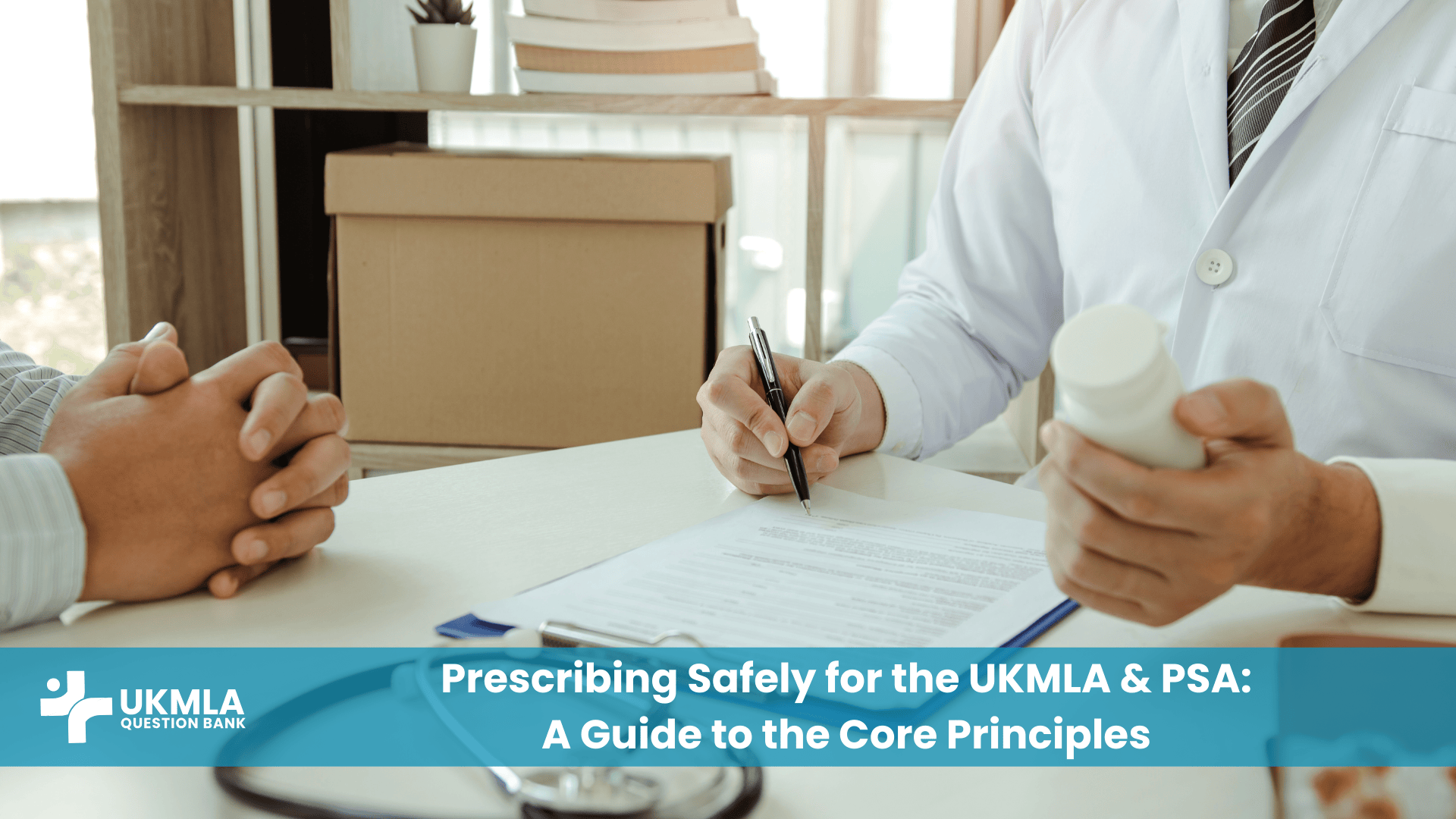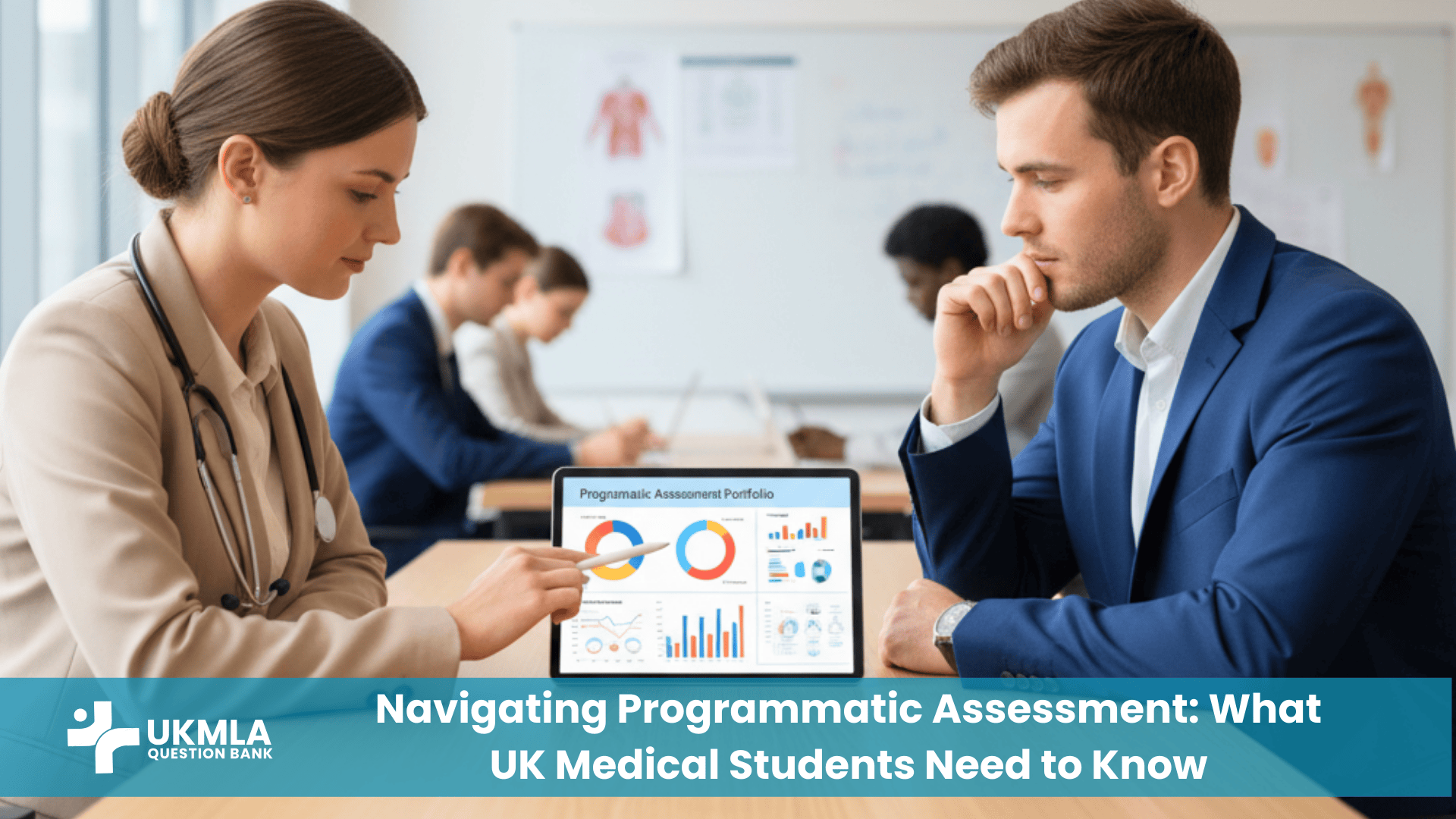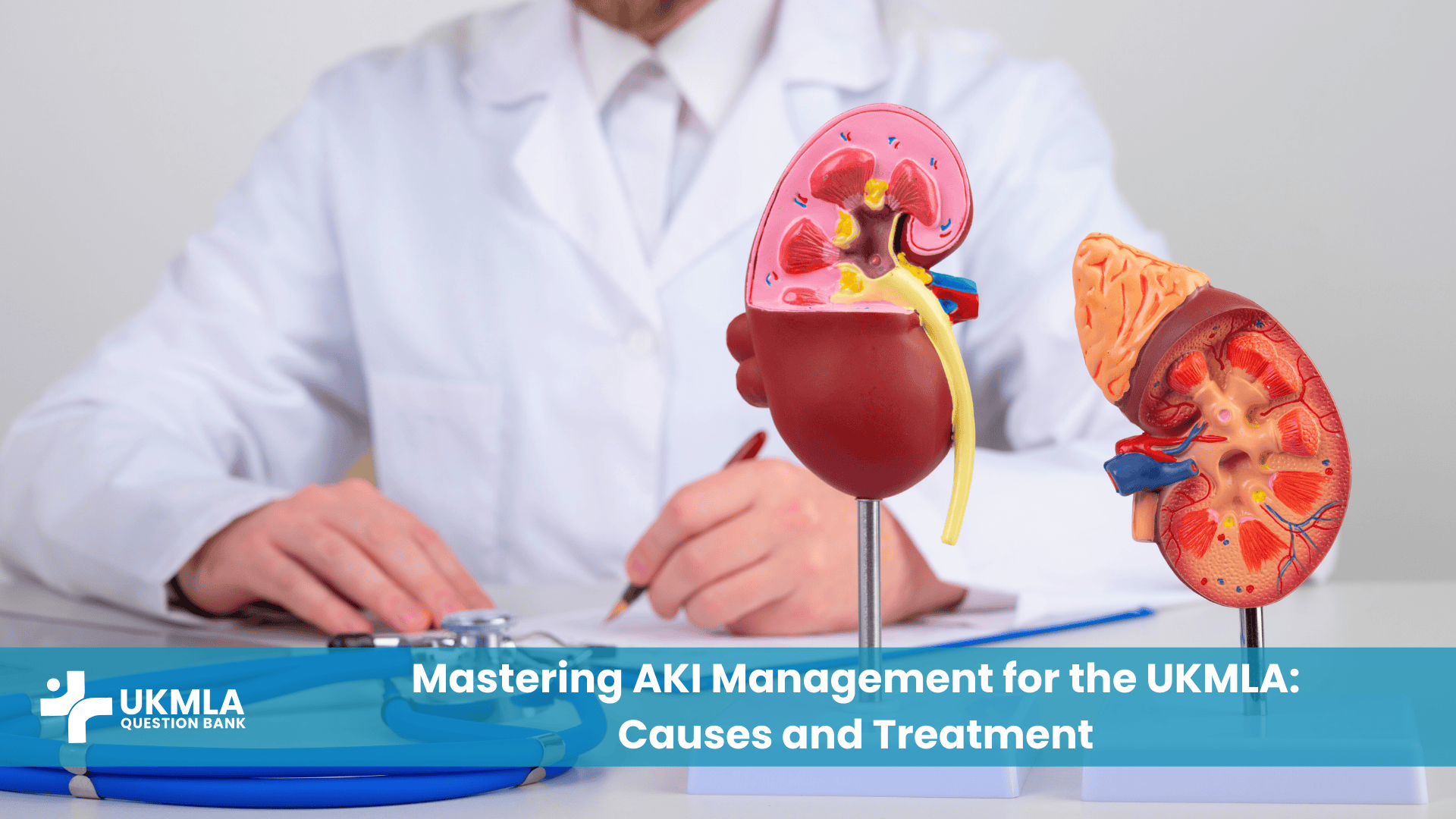Introduction
Mastering UKMLA prescribing safety is arguably one of the most critical and high-stakes skills for any aspiring junior doctor. The moment you sign your first prescription, you take on an immense professional responsibility for your patient’s well-being. This core skill is heavily scrutinized in both the UKMLA and, for UK graduates, the mandatory Prescribing Safety Assessment (PSA). The significant overlap between these exams underscores a fundamental truth: the principles of safe prescribing are universal and non-negotiable. This is a core part of the expectations for UK medical students in their final year.
This guide is designed to be your framework for developing a safe and systematic approach to prescribing. We will move beyond simple drug memorization and focus on the five core principles that underpin every safe prescription. By internalizing this process, you will build a foundation of competence and confidence that will not only help you excel in your exams but will also protect your patients and yourself throughout your medical career.
Table of Contents
ToggleMastering UKMLA Prescribing Safety: The 5 Core Principles
Principle 1: Know Your Patient (The “Right Patient & Context”)
Before your pen even touches the drug chart, your first action must be to thoroughly assess your patient. A prescription that is perfect for one patient can be dangerous for another. This principle is about understanding the full clinical context.
Start by confirming you have the right patient using at least three identifiers (e.g., full name, date of birth, hospital number). Next, you must diligently check for allergies and any previous adverse drug reactions (ADRs). Do not just ask the patient; check their notes, wristband, and drug chart as well.
The next step is a focused review of their clinical status. Are they pregnant or breastfeeding? Do they have any significant comorbidities, particularly renal or hepatic impairment, which would require dose adjustments? Are you aware of their current medications? Checking for potential drug-drug interactions is a vital safety step. This systematic approach is a core tenet of professional guidance.
The GMC’s guidance on “Good practice in prescribing” states: “You must make an adequate assessment of the patient’s condition, taking account of their history (including any previous adverse reactions to medicines) and current condition.”
For definitive guidance, always refer to the full document on Good practice in prescribing and managing medicines and devices.
Principle 2: Know Your Drug (The “Right Drug, Dose, Route & Frequency”)
Once you understand your patient, you must understand the drug you intend to prescribe. The golden rule here is simple but absolute: Always use the British National Formulary (BNF). Whether you use the physical book, website, or app, the BNF is the definitive resource for prescribing in the UK.
When looking up a drug, you must systematically check:
Indications: Is this the correct and licensed drug for the patient’s condition?
Dose, Route, and Frequency: Verify the standard dosage. Does it need adjusting for your patient’s age, weight, or renal function (e.g., eGFR)? Is the intended route (PO, IV, IM, SC) appropriate?
Contraindications: Is there any reason this patient should absolutely not have this drug?
Cautions: Are there situations where the drug can be used but requires extra monitoring?
Common and Serious Side Effects: What should you warn the patient about, and what adverse effects should you monitor for?
This is where your knowledge of high-yield pharmacology for the UKMLA comes into play, but it must always be backed up by a real-time check in the NICE – British National Formulary (BNF).
Principle 3: The Art of Writing the Prescription
A correctly chosen drug can become a source of error if the prescription itself is unclear. This step is about the practical mechanics of writing a safe and legally valid prescription.
Clarity, Legibility, and Documentation
Whether you are writing on a paper chart or using an electronic system, clarity is paramount. Use the approved generic name of the drug, written clearly in capital letters. Avoid ambiguous abbreviations. While many common terms are understood, such as those in our guide to UK medical abbreviations, you must never use any that could be misinterpreted. After writing the prescription, you must document your decision, including the rationale, in the patient’s clinical notes.
The Essential Components of a Valid Prescription
Every prescription, whether for an inpatient, a controlled drug, or for discharge, has a set of mandatory components. Omitting any of these can make the prescription invalid and lead to delays or errors in administration.
Table 1: The Anatomy of a Perfect Prescription (Checklist)
| Component | Why It’s Essential |
|---|---|
| Patient Identifiers | Full name, DOB, hospital number. Ensures the right patient gets the drug. |
| Date | Provides a clear timeline and is a legal requirement. |
| Generic Drug Name | Written in CAPITAL letters to avoid confusion with brand names. |
| Dose | The amount of the drug (e.g., 500 mg, 1 g). Never use ambiguous trailing zeros (e.g., write ‘5’, not ‘5.0’). |
| Route | How the drug is to be administered (e.g., PO, IV, SC). Never abbreviate if there’s ambiguity. |
| Frequency | How often the drug should be given (e.g., OD, BD, TDS, QDS). |
| Your Signature | A legal requirement confirming your authorisation. |
| Your Printed Name & GMC Number | Ensures you can be identified if there are any queries. |
Principle 4: Review and Monitor (The “Right Review”)
Prescribing is a dynamic process. Your responsibility does not end when you sign the chart. You must follow up to ensure the medication is having the desired effect and is not causing harm. This involves monitoring the patient’s clinical parameters (e.g., checking U&Es after starting an ACE inhibitor, monitoring INR for warfarin) and looking out for adverse drug reactions (ADRs). Being able to recognize when a new symptom might be an ADR is a key skill, as some can present as red flag symptoms for the UKMLA. Always schedule a clear review date for any new, significant prescription.
Principle 5: Communication and Patient Partnership
The final principle ties everything together. You must communicate your prescribing decisions clearly to everyone involved. This includes the nursing staff who will be administering the medication, the pharmacy team, and most importantly, the patient themselves.
Explain to the patient in simple, jargon-free language what the medication is for, how to take it, and the key side effects to look out for. Check their understanding and provide an opportunity for them to ask questions. This process of shared decision-making and informed consent is a cornerstone of modern medical practice in the UK.
Common Prescribing Pitfalls and How to Avoid Them
Even with a systematic approach, new prescribers can fall into common traps. Being aware of these can help you build a safer practice from day one.
Table 2: Common Prescribing Errors and Prevention Strategies
| Error | The Pitfall | Prevention Strategy |
|---|---|---|
| “Copy and Paste” Prescribing | Seeing a drug on a previous discharge summary and re-prescribing it without a full review. | Always re-assess the patient and the indication from scratch. The clinical situation may have changed. |
| Interrupting the Task | Getting distracted mid-prescription by a bleep or a question, leading to errors of omission. | Treat prescribing as a “sacred task.” Find a quiet moment or explicitly state, “Please give me one minute to finish this safely.” |
| Prescribing by Brand Name | Writing ‘Tazocin’ instead of ‘piperacillin/tazobactam’. | Always use the generic name unless there is a specific reason not to (e.g., certain epilepsy drugs, lithium). |
| Incomplete Allergy History | Asking “Are you allergic to anything?” instead of “Have you ever had a reaction to any medication?”. | Use open, specific questions. Check multiple sources (patient, notes, wristband) for allergy information. |
Frequently Asked Questions (FAQ) about Prescribing for UKMLA
Prescribing is a core theme integrated throughout the UKMLA content map, particularly under “Areas of clinical practice” and “Areas of professional knowledge.” You can expect to encounter prescribing-related questions in a significant number of AKT scenarios.
No. The UKMLA is the comprehensive exam for medical licensure. The PSA (Prescribing Safety Assessment) is a separate, mandatory exam specifically for UK medical school graduates, designed to test prescribing competency before they start their FY1 year. However, the knowledge and skills they test have a very large overlap.
Absolutely not. The key skill is not memorization but knowing how and when to use the BNF quickly and accurately. The exams test your ability to apply information, not just recall it.
Use online question banks that have dedicated PSA-style questions. Practice writing out full prescriptions. When on clinical placement, actively observe junior doctors prescribing and, under supervision, practice writing prescriptions in patient notes.
PRN stands for pro re nata, a Latin phrase meaning “as needed.” This means the medication is not given at regular intervals but only when the patient requires it for a specific symptom (e.g., paracetamol for a headache).
The terms are often used interchangeably. A side effect is any effect other than the intended therapeutic effect. An adverse drug reaction is a more formal term, defined as any response to a drug which is noxious and unintended.
For variable doses, you must be extremely clear. On a drug chart, each day should have a specific box for the dose to be given. You must write the exact dose for each day (e.g., “3 mg,” “4 mg”) and cross out the days the drug is not to be given.
Controlled drugs are medications that have a potential for abuse or dependence (e.g., strong opioids like morphine). They have much stricter legal requirements for prescribing, storing, and administering, which you must be familiar with.
Politely and professionally explain your concerns. You can say, “I’m not familiar with that drug, could we look it up in the BNF together?” or “I’m concerned about this dose in a patient with renal impairment, could you double-check my thinking?” A good senior will respect your diligence. Your signature means it is your responsibility.
Electronic prescribing can reduce errors related to illegibility and can have built-in decision support (e.g., allergy alerts). However, it can also introduce new types of errors (e.g., “clicking” the wrong drug from a drop-down list). Both methods require the prescriber to be diligent.
Conclusion
Mastering UKMLA prescribing safety is not about memorizing an endless list of drugs. It is about internalizing a systematic, reliable process that you apply every single time you prescribe. By consistently following the five core principles—know your patient, know your drug, write a clear prescription, review and monitor, and communicate effectively—you build a powerful defense against medical error.
This methodical approach will serve you well in the high-pressure environment of the UKMLA and the PSA. More importantly, it will form the foundation of your practice as a safe, competent, and trustworthy junior doctor. Your ability to prescribe thoughtfully and safely is one of the most profound ways you will care for your patients, and it is a skill worthy of your utmost attention and respect.




